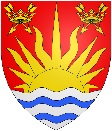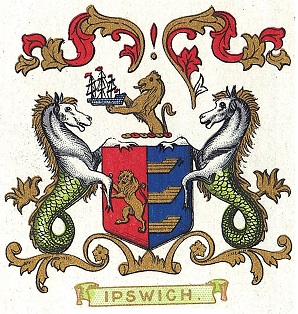
Old Ordnance Survey Maps of Suffolk
This page summarises the local government organisation of Suffolk since 1889.
 Following the Municipal Corporations Act of 1835 Suffolk had six Municipal Boroughs: Beccles, Bury St Edmunds, Eye, Ipswich, Southwold, Sudbury.
Aldeburgh became a Municipal Borough in 1884, and Lowestoft in 1885.
Following the Municipal Corporations Act of 1835 Suffolk had six Municipal Boroughs: Beccles, Bury St Edmunds, Eye, Ipswich, Southwold, Sudbury.
Aldeburgh became a Municipal Borough in 1884, and Lowestoft in 1885.
In 1889 Suffolk was divided into two County Councils, West Suffolk and East Suffolk.
From 1894 a network of boroughs, urban district councils and rural district councils was formed. Ipswich had become a county borough in 1889, giving it relative autonomy.
The more urban areas were covered by Boroughs or Urban Districts. Boroughs had the right to appoint mayors and aldermen; they generally had more
prestige and many larger urban districts aspired to become boroughs. Beneath them rural districts replaced the local boards. Though their powers gradually increased, they replaced Sanitary Boards and in the early days
generally met at the local Workhouse, and often shared the Union's officials.
West Suffolk had the following Municipal Boroughs: Bury St Edmunds, Sudbury. The county town was Bury St Edmunds.
The county had 3 urban districts: Hadleigh, Haverhill, Newmarket. Glemsford became an urban district in 1896 but was abolished in 1935.
It had 8 rural districts: Brandon*, Clare, Cosford, Melford, Mildenhall, Moulton*, Thedwastre, Thingoe. Those marked * were abolished in 1935 and absorbed by adjacent councils.
East Suffolk had the following Municipal Boroughs: Aldeburgh, Beccles, Eye, Lowestoft, Southwold. The county town was Ipswich, though it was a county borough.
The county had 3 urban districts: Felixstowe & Walton (renamed Felixstowe in 1914), Stowmarket, Woodbridge. The following were formed later:
Leiston-cum-Sizewell (in 1895), Halesworth (1900), Saxmundham (1900), Oulton Broad (1904, but absorbed by Lowestoft MB in 1919), Bungay (1910).
It had 10 rural districts: Blything, Bosmere & Claydon, East Stow, Hartismere, Hoxne, Mutford & Lothingland, Plomesgate, Samford, Wangford, Woodbridge.
In 1934 there was major reorganisation into 7 rural districts: Blyth, Deben, Gipping, Hartismere, Lothingland, Samford, Wainford.
In 1974 there was major reorganisation and West Suffolk and East Suffolk were combined into one County Council, Suffolk, with Ipswich as county town.
This is a two-tier county with seven districts: Babergh, Forest Heath, Ipswich, Mid Suffolk, St Edmundsbury, Suffolk Coastal, Waveney.
In 2019 Suffolk Coastal and Waveney districts merged to form East Suffolk District Council; and St Edmundsbury and Forest Heath district councils merged to form West Suffolk District Council.
For a list of our Suffolk maps go to the Suffolk page. A full list of our maps for East Anglia
is given here.
Most maps in the Godfrey Edition are taken from the 25 inch to the mile map and reduced to about 15 inches to the mile.
They cost just £ 3.00 each (Coloured editions £ 4.00). For a full list of English maps, return to the England page
You can order maps direct from our On-line Mapshop.
Minor changes are not listed here, but please advise us of any significant errors or omissions.
Alan Godfrey Maps, Prospect Business Park, Leadgate, Consett, DH8 7PW. Tel 01207 583388
The Godfrey Edition / sales@alangodfreymaps.co.uk / 1 April 2019


 Following the Municipal Corporations Act of 1835 Suffolk had six Municipal Boroughs: Beccles, Bury St Edmunds, Eye, Ipswich, Southwold, Sudbury.
Following the Municipal Corporations Act of 1835 Suffolk had six Municipal Boroughs: Beccles, Bury St Edmunds, Eye, Ipswich, Southwold, Sudbury.